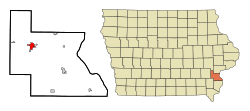Columbus Junction, Iowa facts for kids
Quick facts for kids
Columbus Junction, Iowa
|
|
|---|---|

Downtown Columbus Junction
|
|

Location of Columbus Junction, Iowa
|
|
| Country | |
| State | |
| County | Louisa |
| Area | |
| • Total | 2.09 sq mi (5.42 km2) |
| • Land | 2.09 sq mi (5.42 km2) |
| • Water | 0.00 sq mi (0.00 km2) |
| Elevation | 607 ft (185 m) |
| Population
(2020)
|
|
| • Total | 1,830 |
| • Density | 873.93/sq mi (337.38/km2) |
| Time zone | UTC-6 (Central (CST)) |
| • Summer (DST) | UTC-5 (CDT) |
| ZIP code |
52738
|
| Area code(s) | 319 |
| FIPS code | 19-15420 |
| GNIS feature ID | 0455546 |
| Website | City of Columbus Junction Website |
Columbus Junction is a city in Louisa County, Iowa. In 2020, about 1,830 people lived there. It is part of the larger Muscatine area.
One of the most famous spots in Columbus Junction is the historic Swinging Bridge. This cool bridge is made of steel cables and wood. It was built in 1922 and is 262 feet long. It used to connect Third and Fourth streets. You can find it near downtown, just one block south of Highway 92.
The local schools are part of the Columbus Community School District. This district serves Columbus Junction and several nearby towns. The school colors are blue and white, and their mascot is a wildcat!
A very important business in the city is a Tyson Foods meat processing plant. It is located just north of the city on Highway 70. This plant is the biggest employer in Columbus Junction.
Contents
History of Columbus Junction
Columbus Junction started as a small settlement. It grew up where two important railroad lines met. The Chicago, Rock Island and Pacific Railroad built a line going east-west in 1858. Then, the Burlington, Cedar Rapids and Minnesota Railroad built a line going north-south in 1870. These two lines crossed right where the city is now.
The very first business opened the day after the second train line was finished. It was a restaurant and a place for people to stay. Just a month later, on March 12, 1870, the town was officially planned out.
A nearby town called Columbus City was already there. But the railroads were built a bit far from it. Since the people who invested in the new railroad line got to name the new town, they called it Columbus Junction. This name showed that it was a "junction" (a meeting point) of the railroads, and it was near Columbus City.
Columbus Junction grew a lot between 1960 and 2000. This growth was mainly because of jobs in meat processing. From 1961 to 1982, a company called Rath Packing Company had a hog processing plant there. Later, in 1985, IBP took over the plant. Then, in 2001, Tyson Foods bought it.
People from many different places have moved to Columbus Junction over the years. This has made the city a diverse place. For example, many refugees from the Chin State in Myanmar (Burma) have moved there. Many of them work in the meat processing plants.
In 2008, a big flood in Iowa affected Columbus Junction. Many businesses were damaged. But the community worked hard to recover from the flood.
Geography of Columbus Junction
Columbus Junction is located in Iowa. It sits between the cities of Columbus City and Fredonia. Two rivers meet near the city: the Iowa River and the Cedar River.
The United States Census Bureau says that the city covers about 2.19 square miles (5.42 square kilometers) of land. There is no water area within the city limits.
Population and People
| Historical populations | ||
|---|---|---|
| Year | Pop. | ±% |
| 1860 | 519 | — |
| 1870 | 850 | +63.8% |
| 1880 | 793 | −6.7% |
| 1890 | 953 | +20.2% |
| 1900 | 1,099 | +15.3% |
| 1910 | 1,185 | +7.8% |
| 1920 | 988 | −16.6% |
| 1930 | 867 | −12.2% |
| 1940 | 975 | +12.5% |
| 1950 | 1,123 | +15.2% |
| 1960 | 1,016 | −9.5% |
| 1970 | 1,205 | +18.6% |
| 1980 | 1,429 | +18.6% |
| 1990 | 1,616 | +13.1% |
| 2000 | 1,900 | +17.6% |
| 2010 | 1,899 | −0.1% |
| 2020 | 1,830 | −3.6% |
| Source: and Iowa Data Center Source: |
||
In 2020, the city had 1,830 people living there. The population density was about 873.8 people per square mile. People from many different backgrounds live in Columbus Junction. About 45.4% of the population identified as Hispanic or Latino.
The average age of people in the city was 37.4 years. About 28% of the residents were under 20 years old.
Famous People from Columbus Junction
Some well-known people have connections to Columbus Junction:
- Bill Orr was raised in Columbus Junction. He later became the First Gentleman of Nebraska from 1987 to 1991.
- Billie Ray was born in Columbus Junction in 1928. She is the wife of former Iowa Governor Robert D. Ray. She was the First Lady of Iowa.
- Karl Weber was a television and radio actor. He starred in popular shows like Maverick, Perry Mason, and Dr. Kildare. He was born in Columbus Junction.
See also
 In Spanish: Columbus Junction (Iowa) para niños
In Spanish: Columbus Junction (Iowa) para niños


